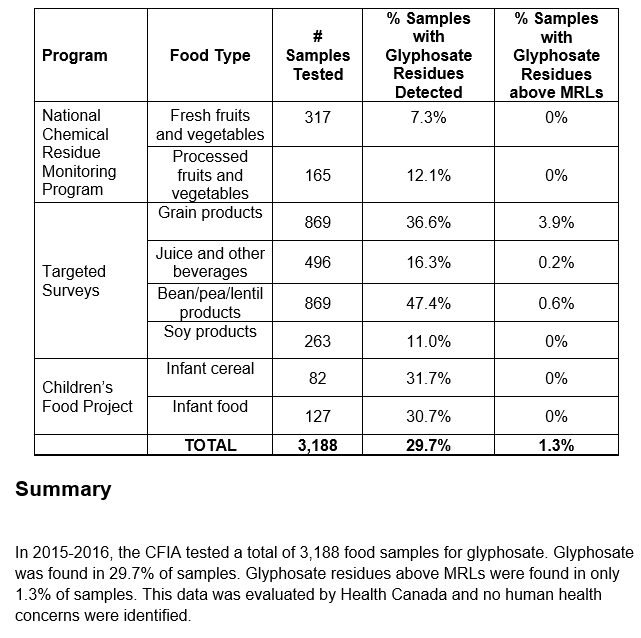
The Canadian Food Inspection Agency has gone where the U.S. government dares not tread – testing thousands of foods commonly consumed by its citizens for residues of a controversial herbicide linked to cancer. And the findings are less than appetizing.
The agency said it found the pesticide known as glyphosate, the key ingredient in Monsanto Co.’s Roundup branded herbicides and other products, in 29.7 percent of 3,188 foods tested in 2015 and 2016. Glyphosate was found in 47.4 percent of beans, peas and lentil products; 36.6 percent of grain products; and 31 percent of baby cereals, the agency report states.

Only 1.3 percent of the total samples were found with glyphosate residue levels above what Canadian regulators allow, though 3.9 percent of grain products contained more of the weed killer than is permissible. These legally allowable levels are referred to as Maximum Residue Limits (MRLs), and they vary from food to food and pesticide to pesticide, as well as from country to country. Regulators and agrichemical industry interests say as long as residue levels are lower than the established MRLs, consuming the pesticide residues is not harmful to humans. But a growing number of scientists and medical professionals say such claims are false, particularly with pesticides like glyphosate, which is the most widely used agrichemical on the planet, commonly used in the production of dozens of food crops. Glyphosate is sprayed directly onto crops like corn, soybeans, sugar beets and canola, all of which are genetically engineered to tolerate the pesticide. Monsanto has also encouraged farmers to spray the chemical directly on oats, wheat, peas and lentils shortly before harvest to help dry them out.
“It’s all guesswork, and not based on a lot,” Dr. Bruce Blumberg, Professor of Developmental and Cell Biology in the University of California, Irvine’s School of Biological Sciences said of the MRLs. “Nobody is actually measuring levels of this pesticide in humans. They don’t do that but they should.”
The World Health Organization’s International Agency for Research on Cancer classified glyphosate as a probable human carcinogen in 2015 and said years of research on the chemical shows strong evidence of genotoxicity and oxidative stress from glyphosate, including findings of DNA damage in the peripheral blood of exposed humans. Many regulatory bodies, including the U.S. Environmental Protection Agency, have determined glyphosate is not carcinogenic, but the issue is the subject of much controversy. Internal Monsanto documents revealed through litigation in California indicate that the company many have ghost-written studies attesting to the safety of the chemical that were relied on by regulators. They also show the company discussing an EPA official that may help “kill” a cancer study of glyphosate.
Oddly, the USDA did intend to start testing some food samples for glyphosate this year, with a start date of April 1, agency documents obtained through Freedom of Information Act requests show. But the agency decided to abandon that plan earlier this year. As well, the FDA started its first-even glyphosate testing program last year but suspended that “special assignment” in September. Even the CFIA has handled the glyphosate testing in a curious manner: The agency said it would not release detailed data on glyphosate residues found in food because it is considered “confidential business information.”
A source within the FDA said there has been political pressure not to delve too deeply into the issue of glyphosate residues. But both the USDA and FDA have said their reasons for not testing have nothing to do with outside influence and are purely based on the fact that glyphosate is more difficult and expensive to test for than other pesticides, and the fact that it is considered safe. The FDA has said it is working on resuming its limited testing of corn, soy, eggs and milk for glyphosate residues.
“I’m not sure what is going on, but it doesn’t smell good,” said Blumberg, who has been active in lobbying Irvine school districts and city leaders to reduce their use of glyphosate and other pesticides in public areas.
